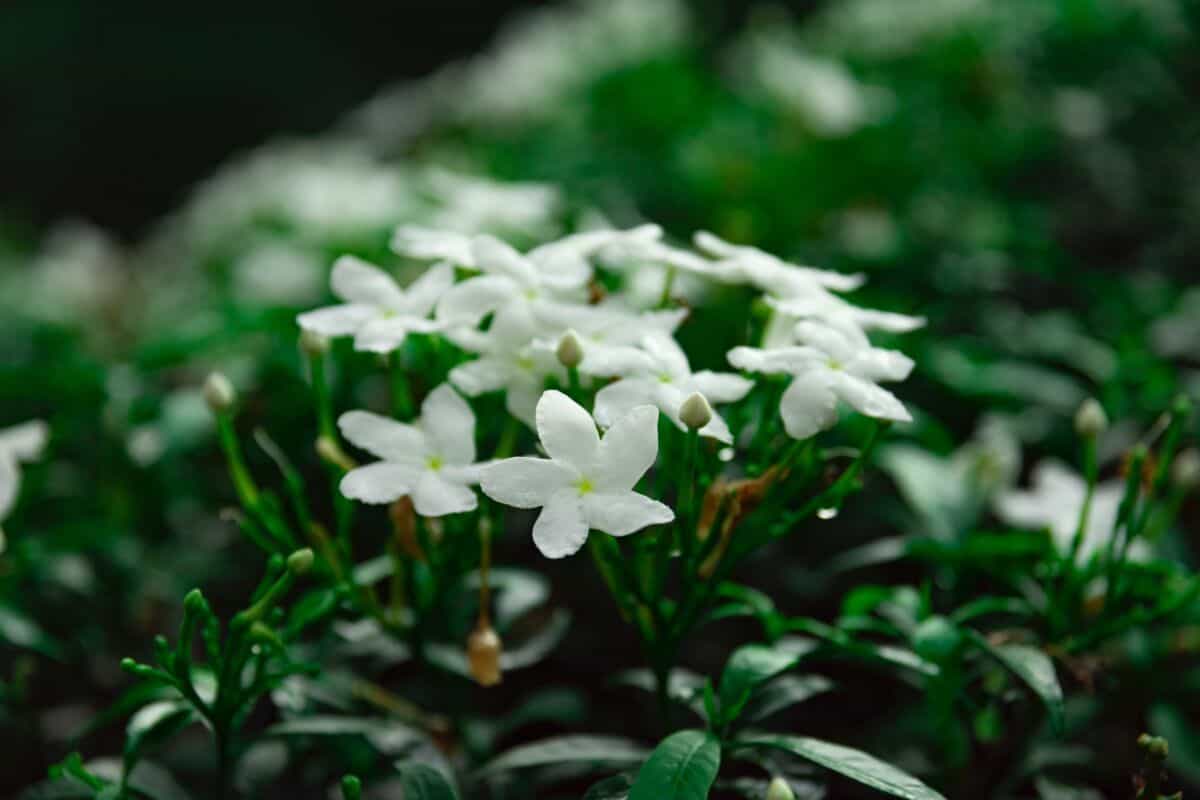Known for their beautiful flowers and exotic fragrance, jasmines are one of the most home-friendly plants. Depending on species, jasmine flowers tend to bloom in white, pink, or yellow colors, making the plants ideal for home or yard decoration. So, with limited space, is it possible to grow jasmine on a balcony?
Jasmine can be grown on a balcony provided basic requirements are met. Since most jasmines are vines, they’ll need a large enough pot with drainage holes, a hoop or trellis for the vine to climb, and rich, fairly acidic potting soil to grow on balconies. The shade is also vital for them to thrive.
Are you interested in learning more about planting jasmine in limited spaces? Read on as we break down how to plant and care for jasmine in pots.
How to Plant Jasmine on a Balcony
Jasmine is great for balcony décor due to its ability to grow as either an outdoor or indoor pot plant. When looking to plant jasmine on your balcony, observe the following steps.
Prepare the Soil
Planting jasmine isn’t as straightforward as most potted plants. These scented plants require rich soil with above-average drainage. You can mix up river sand, loam compost, and peat moss to set up a rich potting soil for your plant. The soil should be slightly acidic to promote the robust growth of the vines.
To test the soil drainage, you should dig a 30 cm (12 inches) hole and fill it completely with water. The soil should drain in less than 15 minutes if it has excellent draining properties.
Choose a Fairly Large Pot With Drainage Holes
The ideal size of a jasmine pot is around 6 inches, which is big enough to support the right quantity of soil. The pot should have drainage holes that help to prevent incidences of over watering the plant.
Proceed to Mix the Ingredients Inside the Pot
You can also add coconut coir or vermicompost to the soil to increase its water retention capacity. Adding components that help to increase water retention will make the soil moist enough to allow for the proper growth of the jasmine.
Plant a Jasmine Seedling in the Pot
You’ll need to be extra careful when placing the jasmine in the pot. Ensure that the seedling is well-placed in the soil such that the roots are completely covered. The crown of the plant should be at the same level as the topsoil.
When planting seedlings, be sure to loosen the roots (carefully) using your hands. Doing so will help the seedling to adapt to its new environment quickly.
Since jasmines thrive in warm temperatures, it’s crucial to place the pot in a strategic location that’ll allow the plant to receive enough sunlight. Besides the regular sunlight, you should also place the pot in a well-shaded area, preferably one that receives 3-4 hours of shade a day.
Water the Jasmine Right After Planting
Watering the seedling immediately after placing it in the soil will help acclimatize to its new environment. Use a hose or water can and pour water until it runs out of the drainage holes. If you choose the right type of soil, the water should be drained easily, leaving the soil damp.
Caring for a Jasmine Plant on a Balcony
To keep your jasmine plant healthy, you’ll need to observe the following:
Water the Jasmine Plant Regularly
Jasmine plants grow well when watered at least once a week, as the soil must be moist enough to keep the plant hydrated at all times. In case you aren’t sure about when to water your potted jasmine, try poking your finger in the soil about 1-2 inches (2.5-5.1cm) deep. Proceed to water the jasmine if the soil is dry.
Disclaimer, you might have to water your potted jasmine less frequently during winter since soil tends to retain water more during cold weather.
Apply Fertilizer on the Jasmine Plant Monthly
Since jasmines thrive in potassium-rich soil, it is advisable to use a fertilizer that’s high in potassium content. Spray the stem, leaves, and soil once every month during spring and summer as the plant is active. Disclaimer, although tempting, it isn’t advisable to fertilize a jasmine plant during the cold season when it is dormant.
Regular fertilization helps to provide the required nutrients for healthy roots, foliage formation, disease resistance, and proper flowering. Potassium-rich fertilizers will also help your potted jasmine to grow and flower normally.
Place a Pebble Tray of Humidifier Close to the Jasmine
A humidifier isn’t necessary if you live in a humid climate as all you’ll need is to place the potted jasmine outside the window for a couple of hours. But if you live in a low-humidity area, a humidifier like the Mist Ultrasonic Humidifier by TaoTronics might be necessary for your jasmine to grow.
A homemade humidifier can also help to keep your jasmine moist enough. To improvise, add water to a tray of pebbles and dip the potted jasmine carefully inside the tray. Let the pot stay in the tray for three to four hours before returning the plant to its normal location.
Prune Dead Flowers and Leaves
The whole idea of growing jasmine indoors is to have your balcony looking neat and attractive. As a result, you should prune your jasmine plant regularly to ensure that it remains healthy and tidy.
Using high-quality pruning shears like the Fiskars Pruning Shears, pinch away the dead stems, flowers, and leaves carefully. Point to note, though, and you shouldn’t prune over 1/3 of the potted plant’s foliage at a go.
Transplant the Jasmine As It Continues to Grow
As a climbing vine, jasmine requires adequate pot space for its root to absorb water and nutrients. And as your potted jasmine continues to grow, you’ll realize that the first pot is no longer large enough to accommodate its growth needs.
You will know that it’s time to transplant the plant when the soil dries too quickly or when the flowers don’t bloom as expected. To prevent roots from cramping up in the potting soil, switching to a bigger pot is recommended.
Be sure to prune the roots as you re-pot your jasmine, but similar to pruning leaves and flowers, only prune the unhealthy parts of the sub roots, retaining more than 80% of the main root.
Observe Lighting and Temperature Requirements
Jasmines require adequate sunlight and warm enough temperatures to mature and flower. These easy-to-maintain plants need at least three hours of direct sunlight each day. However, during winter and fall, you might have to improvise and get a grow light to ensure the jasmine gets its minimum light requirement.
You shouldn’t place your potted jasmine next to fireplaces, heaters, and hot air vents as these conditions are neither ideal for the development of flowers nor the growth of the plant’s vines.
The ideal temperature for jasmines is 65°-70° F (18.3°-21.1°C). Your balcony shouldn’t be too warm as excessively warm temperatures limit the formation of flowers in jasmines.
During the summer, it isn’t advisable to place the jasmine in direct light as extreme heat tends to burn the plant’s delicate leaves. But moving your plant close to the sun during warmer months will promote its health, growth, most importantly, the formation of flowers.
Conclusion
Planting jasmines on balconies can be an exciting way to spruce up your home. Besides its pretty flowers, jasmine is known for its heavenly scent, which helps bring the outdoors directly to your home.
But as you look to grow jasmine on the balcony, it’s crucial to consider factors such as lighting, temperature, soil nutrients, water, and space for growth. As flowering vines, jasmines need adequate space to grow and flower. They also love the shade and indirect sunlight, so try your best to position your potted jasmine in a strategic location for proper growth.

